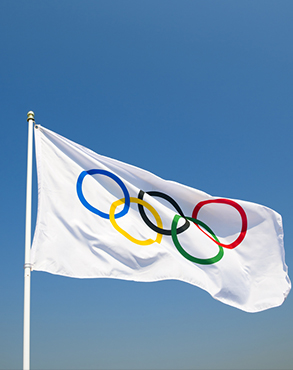David K. Wiggins and Damion L. Thomas
Journal of Olympic Studies (2022) 3 (1): 1–3.
Introduction: Race and the Olympic Games
We thoroughly enjoyed coediting this special issue of the Journal of Olympic Studies (JOS) devoted to “Race and the Olympic Games.” It gave us the opportunity to work closely with colleagues, albeit at different stages of their academic careers, who have a particular interest in studying and sharing information on the interconnection among race, sport, and culture. It also gave us an opportunity to learn more about the role of race in the most important and impactful mega sporting event in the world. In all, we are proud of the issue for its broad scope, a collection of six articles covering the role of race in both the winter and summer Olympic Games in Canada, the United States, and Australia, among such sports as diverse as ice hockey and track and field, and during a period stretching from the early twentieth century to the present day. We are, moreover, very pleased with the quality of the articles, each of them characterized by clear writing, thorough research, and cogent analysis and interpretations. Ultimately, as a collection, the essays fulfill the mission of the JOS which is to publish “high quality academic work.”
The initial article by Neftalie Williams provides fascinating insight into how elite Black skateboarders from the 2020 Olympic team have dealt with and been impacted by race. Utilizing critical race theory and through personal interviews with such outstanding Black skateboarders as Heimana Reynolds, Nyjah Houston, Samarria Brevard, and Dashawn Jordan, Williams gives “voice” to these athletes and explores how they have navigated race and found meaning in a sport that has received relatively scant scholarly attention.
Andrew Linden and Lindsay Parks Pieper furnish an interesting and thoughtful analysis of how Jesse Owens, the great Ohio State star and hero of the 1936 Berlin Olympics, is portrayed in Le Musee Olympique (LMO) in Lausanne, Switzerland, and the National Museum of African American History and Culture (NMAAHC) in Washington, DC. They make clear that Owens is presented in very different ways at the two museums, the LMO choosing to use Owens as a way to represent Olympism and the NMAAHC portraying Owens as part of its theme of Black athlete activism. The most important point to remember, as Linden and Pieper deftly argue, is that both institutions are very selective and intentional in how they portray Owens, providing further proof of the limitations of museums regarding historical remembrances.
Christine O’Bonsawin and Michael Heine provide an interesting and insightful account of the International Tanzwettspiele (ITW), a little known and understudied international dance event held under the auspices of the Olympic Art Competition’s program. They focus specifically on Canada’s participation in the ITW during the famous 1936 Olympics, detailing that the country’s dance performance in Berlin drew on Indigenous culture but took place without engagement of Indigenous individuals or groups. Importantly, O’Bonsawin and Heine make clear that this non-participation is best understood in the context of Canadian settler colonialism.
Gary Osmond, Murray Phillips, and Alistair Harvey also examine the complicated nature of colonialism, but specifically as it relates to boxer Adrian Blair, one of three Indigenous Australian athletes to participate in the 1964 Olympic Games in Tokyo. They examine Blair’s selection for the Olympic Games through a broader analysis of the development of boxing in the Cherbourg Aboriginal Settlement, a very oppressive government reserve in Queensland where Blair was raised a ward of the state. Osmond, Phillips, and Harvey point out in their detailed and thorough analysis how the evolution of boxing in Cherbourg coincided with several important policy shifts in the treatment of Indigenous people from the time of the settlement’s foundation in 1904 to 1964 when Blair competed in the Tokyo Olympics.
In the fifth article, Alexandra Mountain convincingly argues that the famous victory of the United States men’s hockey team over the Soviet Union in the 1980 Olympic Games in Lake Placid, New York, was more than simply a symbolic triumph of democracy over communism during the volatile Cold War era as many scholars have contended. She points out that remembrances of the “Miracle on Ice” appearing in the media and expressed by political figures as well as athletes themselves conjure up images that reinforced the idea that white working-class families were the conventional and superior type for Americans in the context of the late 1970s and early 1980s. In essence, writes Mountain, the nostalgia surrounding the “miracle” normalized whiteness as the ideal in the United States.
Finally, Ornella Nzindukiyimana explores the differing paths and athletic careers of Phil Edwards, the Black British Guiana-born Canadian who captured multiple bronze medals in three different Olympic Games, and Ray Lewis, the Black Canadian from Hamilton, Ontario, who won bronze in the 4×400 meter relay in the 1932 Olympic Games in Los Angeles. Utilizing an impressive list of both primary and secondary sources, Nzindukiyimana provides an insightful analysis of the struggles encountered by the two outstanding Black athletes who represented Canada so well in Olympic competition and how both class and race impacted them on and off the track.
In sum, we hope readers of the JOS will enjoy reading this special issue as much as we have enjoyed putting it together. It provides important details and insightful analysis of the role of race in the modern Olympic Games that should be of interest to a broad audience, including serious scholars of sport and general readers who want to learn more about the world’s greatest international sporting event, which continues to draw enormous attention and media coverage as well as much controversy in the bringing together of finely tuned athletes with extraordinary talent.



